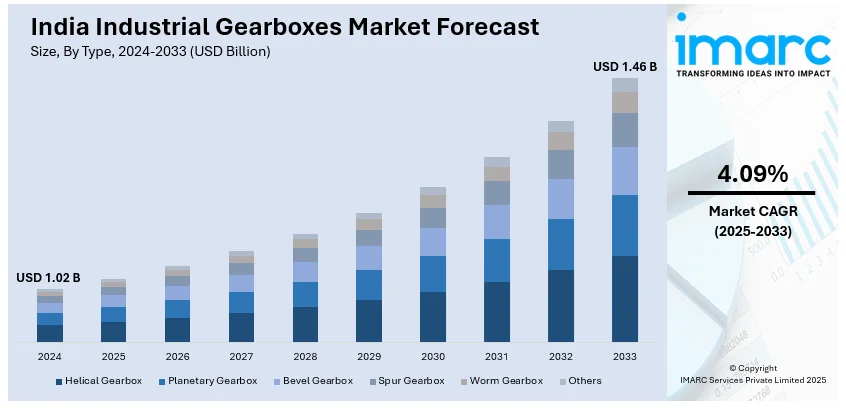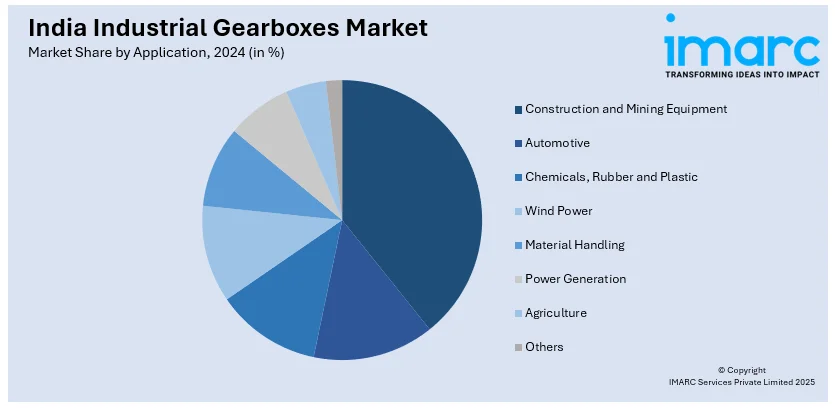
India Industrial Gearboxes Market Size, Share, Trends, and Forecast by Type, Design, Application, and Region, 2025-2033
India Industrial Gearboxes Market Overview:
The India industrial gearboxes market size reached USD 1.02 Billion in 2024. Looking forward, IMARC Group expects the market to reach USD 1.46 Billion by 2033, exhibiting a growth rate (CAGR) of 4.09% during 2025-2033. The market is driven by rising industrial automation, expanding manufacturing sectors, and an increasing demand for energy-efficient transmission systems. Growth in industries like power, cement, and steel, along with advancements in gear technology, is fueling market expansion across various applications.
|
Report Attribute
|
Key Statistics
|
|---|---|
|
Base Year
|
2024 |
|
Forecast Years
|
2025-2033
|
|
Historical Years
|
2019-2024
|
| Market Size in 2024 | USD 1.02 Billion |
| Market Forecast in 2033 | USD 1.46 Billion |
| Market Growth Rate (2025-2033) | 4.09% |
India Industrial Gearboxes Market Trends:
Heightening Shift Towards Automation and Industry 4.0
The amplifying preference for Industry 4.0 and automation is notably impacting the industrial gearboxes sector across India. With industries currently opting for smart manufacturing, requirement for high-performance, precision-engineered gearboxes has elevated. Leading-edge industrial gearboxes are currently being incorporated with real-time monitoring, predictive maintenance, and IoT-enabled diagnostics, enhancing operational efficiency and reducing downtime. Sectors such as automotive, manufacturing, and power generation are leveraging automation-driven gear solutions to improve productivity and energy efficiency. The shift towards robotics and automated material handling systems in warehouses and factories further drives demand for high-torque, reliable gear systems. Additionally, government initiatives like “Make in India” are encouraging domestic manufacturing, accelerating investment in automated machinery that relies on industrial gearboxes. For instance, according to the Press Information Bureau, as of July 2024, 755 applications were approved across several manufacturing and industrial sectors, resulting in a heavy investment of USD 147.6 Billion. As industries continue modernizing, the role of technologically advanced gear solutions will become more prominent, catering to evolving operational needs. This trend is expected to drive significant market growth over the coming years.

Growing Demand for Energy-Efficient and Customized Gear Solutions
The increasing focus on energy efficiency and sustainability is shaping the India industrial gearboxes market. Industries are prioritizing high-efficiency gear solutions to reduce energy consumption and operational costs, leading to a growing demand for optimized gearbox designs with improved performance. Manufacturers are developing lightweight, compact, and high-torque gear systems with minimal energy losses, supporting eco-friendly operations. Additionally, the need for application-specific gearboxes is rising, with industries requiring customized solutions tailored to their operational environments, whether in heavy-duty mining, wind energy, or precision-driven automation sectors. The renewable energy sector, particularly wind power, is a key driver, as advanced gear solutions enhance turbine efficiency. For instance, as per industry reports, India added around 3.4 GW of wind capacity during the year 2024, exhibiting a 21% elevation in wind installation in comparison to previous year. This rapid renewable energy deployment can amplify market demand. Furthermore, stringent regulations on energy consumption and carbon emissions are compelling industries to adopt high-performance, low-maintenance gearboxes. As businesses seek to improve sustainability and operational efficiency, the demand for innovative, energy-efficient industrial gear solutions is expected to expand, shaping future market dynamics.
India Industrial Gearboxes Market Segmentation:
IMARC Group provides an analysis of the key trends in each segment of the market, along with forecasts at the region level for 2025-2033. Our report has categorized the market based on type, design, and application.
Type Insights:
- Helical Gearbox
- Planetary Gearbox
- Bevel Gearbox
- Spur Gearbox
- Worm Gearbox
- Others
The report has provided a detailed breakup and analysis of the market based on the type. This includes helical gearbox, planetary gearbox, bevel gearbox, spur gearbox, worm gearbox, and others.
Design Insights:
- Parallel Axis
- Angled Axis
- Others
A detailed breakup and analysis of the market based on the design have also been provided in the report. This includes parallel axis, angled axis, and others.
Application Insights:

- Construction and Mining Equipment
- Automotive
- Chemicals, Rubber and Plastic
- Wind Power
- Material Handling
- Power Generation
- Agriculture
- Others
A detailed breakup and analysis of the market based on the application have also been provided in the report. This includes construction and mining equipment, automotive, chemicals, rubber and plastic, wind power, material handling, power generation, agriculture, and others.
Regional Insights:
- North India
- South India
- East India
- West India
The report has also provided a comprehensive analysis of all the major regional markets, which include North India, South India, East India, and West India.
Competitive Landscape:
The market research report has also provided a comprehensive analysis of the competitive landscape. Competitive analysis such as market structure, key player positioning, top winning strategies, competitive dashboard, and company evaluation quadrant has been covered in the report. Also, detailed profiles of all major companies have been provided.
India Industrial Gearboxes Market News:
- In October 2024, Bonfiglioli Transmissions unveiled its new automation and industrial plant in Tamil Nadu, India, developed with an investment of USD 38.4 Million. This new facility is set to initiate operations in 2025 and will address the heightening domestic requirement for heavy-duty industrial gearboxes.
- In December 2023, Mill Gears Pvt. Ltd., a prominent India-based industrial innovation firm, unveiled one of the largest gearboxes globally, developed particularly for the sugar mill segment. This pioneering product strives to exhibit a notable leap in the industrial engineering sector and constructing a new benchmark for both exceptional performance and efficacy.
India Industrial Gearboxes Market Report Coverage:
| Report Features | Details |
|---|---|
| Base Year of the Analysis | 2024 |
| Historical Period | 2019-2024 |
| Forecast Period | 2025-2033 |
| Units | Billion USD |
| Scope of the Report |
Exploration of Historical Trends and Market Outlook, Industry Catalysts and Challenges, Segment-Wise Historical and Future Market Assessment:
|
| Types Covered | Helical Gearbox, Planetary Gearbox, Bevel Gearbox, Spur Gearbox, Worm Gearbox, Others |
| Designs Covered | Parallel Axis, Angled Axis, Others |
| Applications Covered | Construction and Mining Equipment, Automotive, Chemicals, Rubber and Plastic, Wind Power, Material Handling, Power Generation, Agriculture, Others |
| Regions Covered | North India, South India, East India, West India |
| Customization Scope | 10% Free Customization |
| Post-Sale Analyst Support | 10-12 Weeks |
| Delivery Format | PDF and Excel through Email (We can also provide the editable version of the report in PPT/Word format on special request) |
Key Questions Answered in This Report:
- How has the India industrial gearboxes market performed so far and how will it perform in the coming years?
- What is the breakup of the India industrial gearboxes market on the basis of type?
- What is the breakup of the India industrial gearboxes market on the basis of design?
- What is the breakup of the India industrial gearboxes market on the basis of application?
- What is the breakup of the India industrial gearboxes market on the basis of region?
- What are the various stages in the value chain of the India industrial gearboxes market?
- What are the key driving factors and challenges in the India industrial gearboxes market?
- What is the structure of the India industrial gearboxes market and who are the key players?
- What is the degree of competition in the India industrial gearboxes market?
Key Benefits for Stakeholders:
- IMARC’s industry report offers a comprehensive quantitative analysis of various market segments, historical and current market trends, market forecasts, and dynamics of the India industrial gearboxes market from 2019-2033.
- The research report provides the latest information on the market drivers, challenges, and opportunities in the India industrial gearboxes market.
- Porter's five forces analysis assist stakeholders in assessing the impact of new entrants, competitive rivalry, supplier power, buyer power, and the threat of substitution. It helps stakeholders to analyze the level of competition within the India industrial gearboxes industry and its attractiveness.
- Competitive landscape allows stakeholders to understand their competitive environment and provides an insight into the current positions of key players in the market.
Need more help?
- Speak to our experienced analysts for insights on the current market scenarios.
- Include additional segments and countries to customize the report as per your requirement.
- Gain an unparalleled competitive advantage in your domain by understanding how to utilize the report and positively impacting your operations and revenue.
- For further assistance, please connect with our analysts.
 Inquire Before Buying
Inquire Before Buying
 Speak to an Analyst
Speak to an Analyst
 Request Brochure
Request Brochure
 Request Customization
Request Customization




.webp)




.webp)












